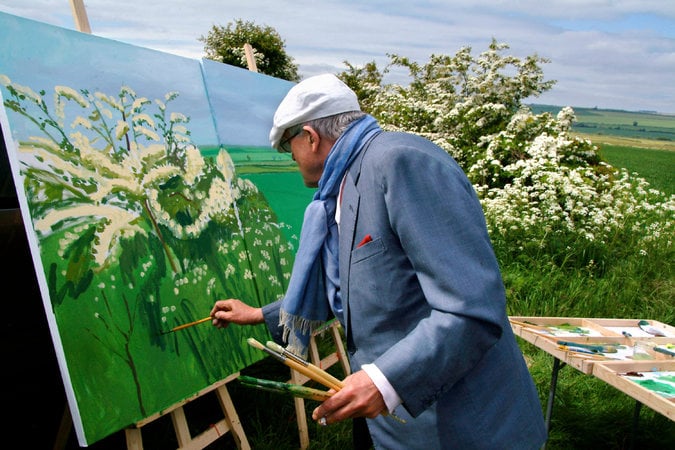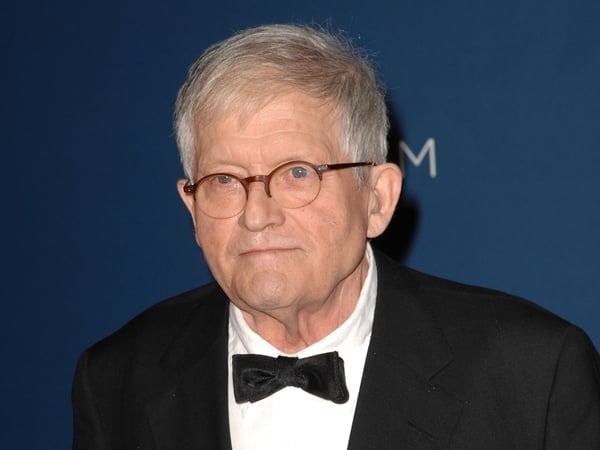People
8 David Hockney Quotes on the Masters, Art History, and Why We Love Selfies
David Hockney has a new book on art history.

Photo: Jean-Pierre Goncalves de Lima/Film Movement.
David Hockney has a new book on art history.

British artist David Hockney is a portrait master who paints and draws prolifically, as exhibitions featuring his recent work on the iPad definitively prove. But what does Hockney think drives the impulse to make art, and how does he think history’s great artists attempted to depict the world, and what makes a work great?
That’s the subject of A History of Pictures: From the Cave to the Computer Screen, Hockney’s new book with art critic Martin Gayford, due out October 18.
“I think people have a deep desire to make pictures,” Hockney told the Guardian, arguing that the proliferation of selfie culture is merely the extension of that innate drive. The smart phone, therefore, is a tool that makes it possible for anyone to instantly fulfill that longing—once the purview of artists alone.

David Hockney.
Photo: © 2014 Patrick McMullan Company, Inc.
The Guardian has published a long excerpt from the forthcoming publication, with Hockney’s insightful observations on a number of topics, including the history of art, what makes a masterpiece, and how the great artists of the past approached their practice. Here are some highlights:
“The moment you put down two or three marks on a piece of paper, you get relationships. They’ll start to look like something. If you draw two little lines they might look like two figures or two trees. One was made first, one second. We read all kinds of things into marks. You can suggest landscape, people and faces with extremely little. It all depends on the human ability to see a mark as a depiction.”
“It is a kind of joke, but I really mean it when I say Caravaggio invented Hollywood lighting. It is an invention, in that he quickly worked out how to light things dramatically. I’ve always used shadows a bit, because that’s what you need below a figure to ground it, but mine are more like Giotto’s than Caravaggio’s. I use shadows that you see in ordinary lighting conditions; you don’t find ones like Caravaggio’s in nature.”

Leonardo da Vinci, Mona Lisa (1503–1517). Courtesy of Wikipedia Commons.
“The Mona Lisa is one of the first portraits with very blended shadows. That face is marvelously lit, the shadow under the nose, and that smile. The soft transition from the cheekbone down to underneath the jaw is extraordinary. The way that you move from the light to the dark flesh is achieved with incredibly subtle, graded paint that would have taken a long time to put on. I’ve no idea how he did it. You don’t quite see it in nature, but you certainly do in optical projections. Those unbelievably soft gradations look photographic. That’s what makes it remarkable, and why she has that enigmatic smile. It is a haunting face.”
“We see with memory, so if I know someone well, I see them differently from the way I might if I’ve just met them. And my memory is different from yours; even if we are both standing in the same place, we’re not quite seeing the same thing. Other elements are playing a part; whether you have been in a place before will affect you, and how well you know it.”
“The eye is always moving; if it isn’t moving you are dead. The perspective alters according to the way I’m looking, so it’s constantly changing. In real life when you are looking at six people there are a thousand perspectives. I’ve included those multiple angles of vision in paintings of friends in my studio. If a figure is standing near to me, I look across at his head but downwards at his feet. A still picture can have movement in it because the eye moves.”

Jan van Eyck, Arnolfini Wedding Portrait (1434). Courtesy of Wikimedia Commons.
“Renaissance European perspective has a vanishing point, but it does not exist in Japanese and Chinese painting. And a view from sitting still, from a stationary point, is not the way you usually see landscape; you are always moving through it. If you put a vanishing point anywhere, it means you’ve stopped. In a way, you’re hardly there.”
“The extraordinary thing about Van Eyck is how he comes out of nowhere, and has somehow worked out how to translate into paint the different kinds of sheen on brocade cloth, glass, wood, different kinds of metal, stone, glass, wax, flesh, and all sorts of diverse shine and reflections, all absolutely perfectly…. It isn’t possible to paint like that from imagination. So his workshop must have been close to a Hollywood movie: costumes, lighting, camera, let’s go!”
“Rembrandt put more in the face than anyone else ever has, before or since, because he saw more. And that was not a matter of using a camera. That was to do with his heart. The Chinese say you need three things for paintings: the hand, the eye and the heart. I think that remark is very, very good. Two won’t do. A good eye and heart is not enough, neither is a good hand and eye.”